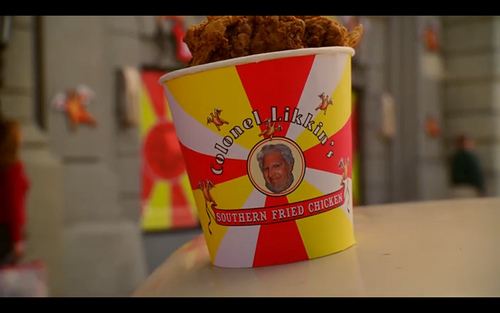- Diesel’s new watch: Style trumps functionality: Yes, another example of counterfunctionality in the watch world, a favorite topic of mine, as you know. “The watch face is perplexingly blank; but two micro-clocks on each side of the casing provide a total of four timetelling indicators.” $365.
- Product Displacement, continued: Follow-up on Eyecube contains other interesting examples.
- Cover versions – a set on Flickr: Classic records lost in time and format, re-emerged as Pelican books. Super! Via Listenerd
- On the electric guitar: “It is the symbol of liberation for the very practical reason that the guitarist can wander around while playing. He can smoke, spit or even sing while he plays. Electric guitarists.. are the dancers among modern musicians. Even Madonna has occasionally adopted a guitar as the necessary pendant of strutting musicianship. It is better to dance a bit with a guitar (Keith Richards) than dance a lot without one (Mick Jagger).” I don’t agree with everything in this essay, but the guy makes some pretty interesting observations.
- 25 logos with hidden messages: Via coudal
Posted Under:
Non-Daily Linkpile
This post was written by Rob Walker on May 13, 2009
Comments Off on Linkpile (via Delicious)

As some of you know, I have (https://comfortdentalcareofbrookline.com/order-zithromax-500mg-online/) a particular fascination with imaginary brands — it’s a subject that’s come up in Consumed (here and here), and on this site, and in my Delicious links. So I was extremely interested to learn of this Tumblr blog, curated by Gladys Santiago, documenting what she calls “product displacement.”
This involves the use of imaginary brands as, in effect, stand-ins for real brands we already know. For instance, above, a bucket of Colonel Likkin’s Southern Fried Chicken. I don’t have to tell you what that stands in for. Apparently it was used on the TV show Pushing Daisies. Other examples: Coffee Bucks on Scrubs, and TitTat candy on My Name Is Earl. (The Product Displacement blog also documents instances of unbranding — as when the logos are removed from cars and so on — but I’m not going to address that here.)
Santiago (who I got to meet, briefly, the other night at the Blowing Up The Brand event) explains the parameters of product displacement here. And here she argues that some product displacements are “arguably more clever and memorable than even some of the most exhaustedly planned brand integration strategies. ”
It requires no stretch of the imagination to recognize “Tit Tat” and “Coffee Bucks” as stand-ins for real brands, but that recognition allows audiences to engage with product placements in a manner that is significantly more encompassing than simply spotting a branded product onscreen. Referencing these product displacements to their real world counterparts requires audiences to actively draw upon their cultural capital and awareness, therefore they have more resonance than a strategically placed can of Coca-Cola or character mindlessly raving about his/her T-Mobile phone.
Ultimately, product displacements have the opportunity to flatter the intelligence of viewers, especially if they are parodic and satirical in nature. I particularly like My Name is Earl and Scrubs examples because they provide an allure of audience members being in on a private joke that mocks Kit Kat and Starbucks.
Pretty interesting!
Oh, and Santiago has also created this massive Flickr set of “deliberate and unintentional” examples of product appearances in scripted shows.
UPDATE: Follow-up posts worth a look on Eyecube, and AdFreak.
Posted Under:
Entertainment,
Imaginary Brands
This post was written by Rob Walker on May 12, 2009
Comments Off on Imaginary brands as “product displacement”
- What Lucha Libre is about: “In the heart of the fight card, a deeper conflict played on the racial tensions and stereotypes of a downtrodden immigrant audience. Among the wrestlers, the vilest of the vile were the members of La Legíon Extranjera, the Foreign Legion, gringos who openly disparaged the spectators, their language and their country. The invasion, in this sense, referred to the chance for the Mexican heroes to drive out the Foreign Legion.”
- As Storefronts Become Vacant, Ads Arrive: “Taking advantage of all the abandoned retail spaces in urban areas, marketers are leasing them at cut-rate prices and filling them with their ads.”
- The Optimist Conspectus: “Simply a survey of optimism; a series of answers to a deceptively-simple question: What are you optimistic about?” Via Swissmiss.
- Shift From Spending to Saving May Be Slump’s Lasting Impact: “This is not because Americans have suddenly become more financially virtuous or have learned the error of their free-spending ways. Instead, these experts say, Americans may have no choice but to continue pinching pennies.”
- Pimp That Snack: Totally disturbing site gives DIY instructions for making immense versions of Twix, Kit Kat, other junk food. Courtesy of Rebecca W. on Consumed’s Facebook page.
- Product Displacement: Fascinating tumblog. More on this later.
- The Surprising Satisfactions of a Home Funeral: Pretty interesting.
Posted Under:
Non-Daily Linkpile
This post was written by Rob Walker on May 12, 2009
Comments Off on Linkpile (via Delicious)

The current Giant Robot brings my attention to the work of Masakatsu Sashie, and I like it a lot.
Do I like it enough to reverse my decision to let my GR sub lapse? Well, no. But still. Really good stuff. I’d love to see it in real life. Meanwhile, check the artist’s site.
Posted Under:
Artists,
Just Looking
This post was written by Rob Walker on May 11, 2009
Comments Off on Just Looking
Posted Under:
Non-Daily Linkpile
This post was written by Rob Walker on May 10, 2009
Comments Off on Linkpile (via Delicious)
 BIG CHEESE:
BIG CHEESE:
Is largeness its own reward?
We think of ourselves as sophisticated creatures, and the many brilliant minds of the consumer-industrial complex often think of us that way, too. But sometimes what we want seems pretty simple. Sometimes, we just want something big.
A case in point, perhaps: giant Cheetos….
Read the column in the May 10, 2009, New York Times Magazine, or here.
Discuss, make fun of, or praise this column to the skies at the Consumed Facebook page.
Posted Under:
Consumed
This post was written by Rob Walker on May 9, 2009
Comments Off on In The New York Times Magazine: Cheetos Giant
… to those who came out to the Blowing Up The Brand event last night. Great to see some old pals, meet some new people, and it’s always a highlight to get meet readers I’ve been in touch with only via email etc. (And it’s always a drag that some conversations/meetings are shorter than is ideal.) I owe some of you some correspondence now and will get to that in the next day or two, but I wanted to also thank Melissa Aronczyk and Deveon Powers having me. Good luck with today’s events!
Also since I talked about Twitter, I had to do a quick search this morning to see if any of you were tweeting. And you can guess the answer.
(Thanks also to Mobile Libris — a very fine business that I endorse.)
Posted Under:
Uncategorized
This post was written by Rob Walker on May 9, 2009
Comments Off on Thanks…
- Choice blindness: “Role of ‘narratization,’ the ability of the mind to make a coherent story out what’s happening, with you as the main character, even when it’s clear that the outcome was determined externally.” Interesting writeup with several good links.
- More on attention: “It may be possible to improve your attention by using pulses of light to directly synchronize your neurons.” Yikes! Anyway I’m surprised that so far in the writing about Rapt I haven’t seen mention of Csikszentmihalyi’s “flow” idea. But maybe I haven’t been paying close enough attention.
- Lunch Bag Art: Pretty amazing, no? Via Amy Shaw/ Unconsumption.tumblr.com.
- Mass media helps Web media again.: This item mentions in passing that Twitter has grown *40 percent a week* since Oprah hyped it.
Posted Under:
Non-Daily Linkpile
This post was written by Rob Walker on May 7, 2009
Comments Off on Linkpile (via Delicious)

Steve Lambert has images & even a video added to his site in connection with his current show in Los Angeles. Cool stuff, check it out here.
Posted Under:
Just Looking,
To Do
This post was written by Rob Walker on May 6, 2009
Comments Off on Just looking
As mentioned repeatedly: Talk + book signing at NYU’s Blowing Up The Brand, Friday night. Details & RSVP here.
Also: At the end of the 8:20 pm Saturday screening of Objectified at IFC Center, I’ll join director Gary Hustwit for a brief audience Q&A.
Posted Under:
rw,
To Do
This post was written by Rob Walker on May 6, 2009
Comments Off on Me in NYC: Reminder + new development (won’t mention it again, sorry)
- Attention grabber: Marginal Utility adds another thought to the just-linked Laura Miller essay, addressing the possibilities of “unremembered pleasures.”
- Why can’t we concentrate?: If you can focus long enough to read this, you may learn something. “While it’s one thing to accommodate more information, it’s another to engage with it fundamentally, in a way that allows us to perceive underlying patterns and to take concepts apart so that we can put them back together in new and constructive ways.”
- Studying “The holier-than-thou effect.”: “Long known that people tend to be overly optimistic about their own abilities and fortunes — to overestimate their standing in class, their discipline, their sincerity. But this self-inflating bias may be even stronger when it comes to moral judgment, and it can greatly influence how people judge others’ actions, and ultimately their own.”
- Multi-Platform ‘Mackenzie Blue’ Arrives: Brands mentioned, but author says no paid deals.
- Default Avatars critiqued: By Social Images: Seeing Is Believing.
- Ambivalent Parenting 101: Latest from Adult Education: Brooklyn’s favorite useless lecture series. Tuesday May 5.
Posted Under:
Non-Daily Linkpile
This post was written by Rob Walker on May 5, 2009
Comments Off on Linkpile (via Delicious)
- YouTube: Placement Police: Cracking down on unauthorized (by YouTube) murketing: “Kevin Nalty, a marketing director at Merck & Co., who produces a series of sophomoric videos on YouTube under the moniker ‘nalts,’ recently received a slightly scary e-mail from YouTube about one of his videos containing brand messaging.” By the way, why is Merck posting “sophomoric” videos? Why does that make sense?
- Wasting Time: Priceless: I don’t disagree, but why is this a Web-specific issue? Same is true of watching TV or looking out the window, no?
- Depression Scares Are Hardly New: Argues that measures suggest three previous periods when there was more fear of a new depression than there is today: 1974/1975, 1978-1982, and 1990-1992. I find this genuinely surprising. In particular I don’t remember any talk of a new depression in 1990-1992 at all — bad economy, yes, but depression talk? That just doesn’t line up with what I can recall.
- Might become a ‘Super Fan’ of a popular movie franchise 4 the rest of my life.: HRO on fandom: “Sort of prefer ‘wasting time on the internet’ because we are all trying to get vulnerable and ’show the world who we are.’”
- Michelle Obama: Sneakerhead: Spotted rocking $540 kicks.
Posted Under:
Non-Daily Linkpile
This post was written by Rob Walker on May 4, 2009
Comments Off on Linkpile (via Delicious)
 IMMATERIALISM
IMMATERIALISM
With more of life lived online, spending on things that don’t seems more normal.
I’ve actually been scooped by Core77 in posting my own column! Embarrassing. Anyway, Consumed this week is about immaterialism and digital goods — why people buy things that don’t exist.
Consuming things made of bits might sound weird, but actually it offers a lot of the same attractions that make people consume things made of atoms. Facebook’s digital gifting is one relatively mainstream example.
Other examples, and the case for what it all has in common with buying things that do exist, in the full column in the May 3, 2009, issue of The New York Times Magazine, or here.
Discuss, make fun of, or praise this column to the skies at the Consumed Facebook page. For information about writing a letter to the editor, see the FAQ.
Consumed archive is here. The Times‘ Consumed RSS feed is here. Facebook users: Become a Consumed “fan” here.
Posted Under:
Consumed
This post was written by Rob Walker on May 2, 2009
Comments Off on In The New York Times Magazine: Digital goods




 "
"


 BIG CHEESE:
BIG CHEESE:












 Kim Fellner's book
Kim Fellner's book  A
A